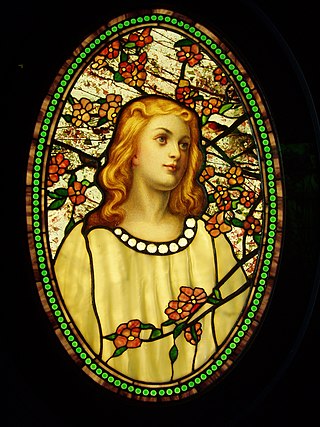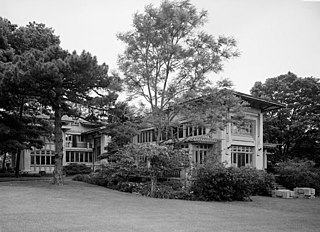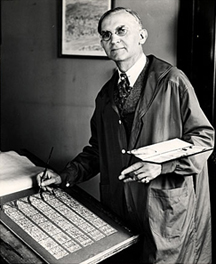
Louis Comfort Tiffany was an American artist and designer who worked in the decorative arts and is best known for his work in stained glass. He is associated with the art nouveau and aesthetic art movements. He was affiliated with a prestigious collaborative of designers known as the Associated Artists, which included Lockwood de Forest, Candace Wheeler, and Samuel Colman. Tiffany designed stained glass windows and lamps, glass mosaics, blown glass, ceramics, jewellery, enamels, and metalwork. He was the first design director at his family company, Tiffany & Co., founded by his father Charles Lewis Tiffany.

Stained glass is colored glass as a material or works created from it. Although, it is traditionally made in flat panels and used as windows, the creations of modern stained glass artists also include three-dimensional structures and sculpture. Modern vernacular usage has often extended the term "stained glass" to include domestic lead light and objets d'art created from foil glasswork exemplified in the famous lamps of Louis Comfort Tiffany.

John La Farge was an American artist whose career spanned illustration, murals, interior design, painting, and popular books on his Asian travels and other art-related topics. La Farge made stained glass windows, mainly for churches on the American east coast, beginning with a large commission for Henry Hobson Richardson's Trinity Church in Boston in 1878, and continuing for thirty years. La Farge designed stained glass as an artist, as a specialist in color, and as a technical innovator, holding a patent granted in 1880 for superimposing panes of glass. That patent would be key in his dispute with contemporary and rival Louis Comfort Tiffany.

The Chicago Cultural Center, opened in 1897, is a Chicago Landmark building operated by Chicago's Department of Cultural Affairs and Special Events. The Cultural Center houses the city's official reception venue, where the Mayor of Chicago has welcomed presidents, royalty, diplomats, and community leaders. It is located in the Loop, across Michigan Avenue from Millennium Park.

Favrile glass is a type of iridescent art glass developed by Louis Comfort Tiffany. He patented this process in 1894 and first produced the glass for manufacture in 1896 in Queens, New York. It differs from most iridescent glasses because the color is ingrained in the glass itself, as well as having distinctive coloring. Tiffany won a grand prize at the 1900 Paris Exposition for his Favrile glass.

Blenko Glass Company is an art glass company that began producing in 1922 under the name Eureka Art Glass Company. The company name was changed to Blenko Glass Company in 1930. Originally an antique flat glass company, it was founded by Englishman William J. Blenko (1854-1933). Blenko came to the United States to make glass in 1893. Over the next 25 years, he established glass factories in Indiana, Pennsylvania, and West Virginia—which all failed. His fourth glass factory, that began production in 1922, was a success and still operates today (2024). This factory is located in Milton, West Virginia, and Blenko family members still lead the company.
The Smith Museum of Stained Glass Windows was an exhibition that opened in February 2000 at Chicago’s Navy Pier entertainment complex. It permanently closed in October 2014. It was the first American museum dedicated solely to the art of stained glass windows.

Tiffany glass refers to the many and varied types of glass developed and produced from 1878 to 1929–1930 at the Tiffany Studios in New York City, by Louis Comfort Tiffany and a team of other designers, including Clara Driscoll, Agnes F. Northrop, and Frederick Wilson.

Brown Memorial Park Avenue Presbyterian Church of Baltimore, Maryland, U.S., is a large, Gothic Revival-style church built in 1870 and located at Park Avenue and Lafayette Avenue in the city's Bolton Hill neighborhood. Named in memory of a 19th-century Baltimore financier, the ornate church is noted for its exquisite stained glass windows by artist Louis Comfort Tiffany, soaring vaulted ceiling, and the people associated with its history. Maltbie Babcock, who was the church's pastor 1887–1900, wrote the hymn This is My Father's World. Concert performer Virgil Fox was organist at Brown Memorial early in his career (1936–1946).

The Bernard Corrigan House is a historic residence at 1200 West 55th Street in the Country Club District, Kansas City, Missouri. The building is an important regional example of the Prairie Style, and it was one of the earliest residential structures in Kansas City to make extensive use of reinforced concrete. It was added to the National Register of Historic Places in 1978.

William Willet was an American portrait painter, muralist, stained glass designer, studio owner and writer. An early proponent of the Gothic Revival and active in the "Early School" of American stained glass, he founded the Willet Stained Glass and Decorating Company, a stained glass studio, with his wife Anne Lee Willet, in protest against the opalescent pictorial windows which were the rage at the turn of the twentieth century.

Charles Jay Connick (1875–1945) was a prominent American painter, muralist, and designer best known for his work in stained glass in the Gothic Revival style. Born in Springboro, Pennsylvania, Connick eventually settled in the Boston area where he opened his studio in 1913. Connick's work is contained in many preeminent churches and chapels, including examples in Boston, Chicago, Detroit, New York City, Pittsburgh, San Francisco, Seattle, and Washington, D.C. He also authored the book Adventures in Light and Color in 1937. Connick's studio continued to operate, and remained a leading producer of stained glass, until 1986.

Angel of the Resurrection is a massive stained glass window by the American Art Nouveau glass manufacturer Tiffany Studios, now in the collection of the Indianapolis Museum of Art (IMA). It was commissioned by former-First Lady Mary Dimmick Harrison as a memorial to her husband, President Benjamin Harrison. Designed by Frederick Wilson and completed in 1904, the window depicts the Archangel Michael calling for the dead to rise at the Second Coming.

Hartford City Glass Company was among the top three window glass manufacturers in the United States between 1890 and 1899, and continued to be one of the nation's largest after its acquisition. It was also the country's largest manufacturer of chipped glass, with capacity double that of its nearest competitor. The company's works was the first of eight glass plants that existed in Hartford City, Indiana during the Indiana Gas Boom. It became the city's largest manufacturer and employer, peaking with 600 employees.

The Trinity Episcopal Church, Staunton VA. is a Gothic Revival style building in Staunton, Virginia. It is an active Episcopal church in the Diocese of Southwestern Virginia. It was listed on the National Register of Historic Places (NRHP) in 1972. It is located in the Newtown Historic District.

Frederick Wilson was a British stained glass artist best known for his work with the American Art Nouveau glass manufacturer Tiffany Studios in New York. He was a prominent and prolific designer of ecclesiastical windows in the United States during the late 19th and early 20th centuries, designing more than 500 windows in his three decades with Tiffany Studios.

Art Nouveau glass is fine glass in the Art Nouveau style. Typically the forms are undulating, sinuous and colorful art, usually inspired by natural forms. Pieces are generally larger than drinking glasses, and decorative rather than practical, other than for use as vases and lighting fittings; there is little tableware. Prominently makers, from the 1890s onwards, are in France René Lalique, Emile Gallé and the Daum brothers, the American Louis Comfort Tiffany, Christopher Dresser in Scotland and England, and Friedrich Zitzman, Karl Koepping and Max Ritter von Spaun in Germany. Art Nouveau glass included decorative objects, vases, lamps, and stained glass windows. It was usually made by hand, and was usually colored with metal oxides while in a molten state in a furnace.

Benjamin Sellers (1860–1930) was a stained glass artisan in the Northeastern US. He was a practitioner of the opalescent style of stained glass popularized by John La Farge and Louis Comfort Tiffany in the late 19th century.

The Sunset Scene is a window glass artwork created by Tiffany Studios around 1915. This artwork was created to symbolize the distinct line between life and death.Tiffany Studios manufactured many stained glass pieces, the scene was one of a couple of windows created for Mount Hope Cemetery in Rochester New York. Many of these window pieces have been created in relation to religion and personal interior home decor and other decorating purposes.

Agnes Northrup was an American glass artist. She is best known for her design work for Louis Comfort Tiffany and for work in iridescent glass.


















